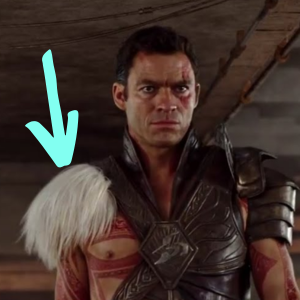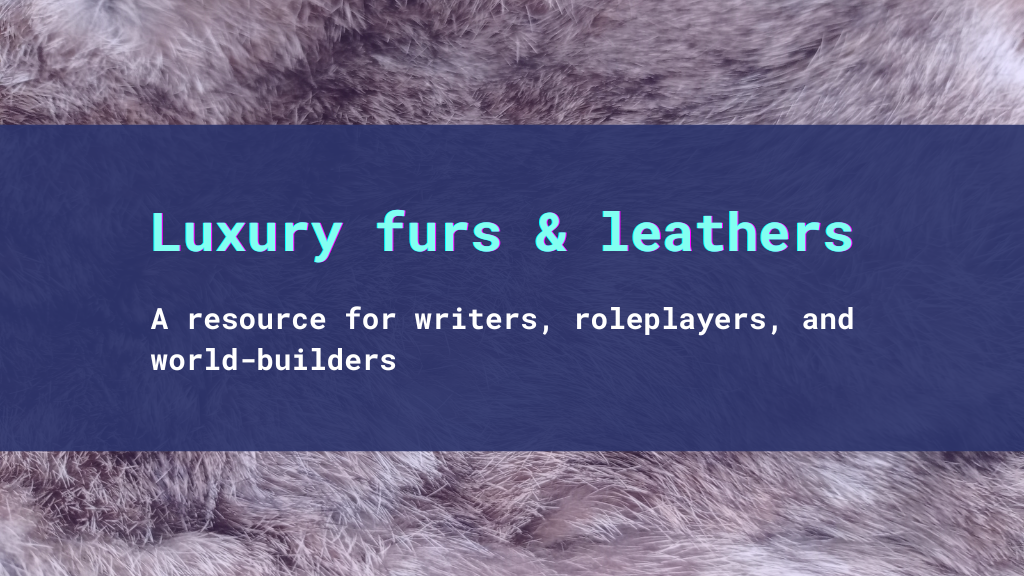This post is part of a small series on luxury fabrics and how luxury fabrics are made.
Below, I’ll walk you through a hand-picked list of the luxury furs and leathers used by the elite throughout history. This list is designed to help you choose the right materials to convey wealth, status, or nobility in your fictional works.
At the same time, I think it’s good to be aware of the ongoing animal welfare concerns related to these materials – as well as the faux alternatives gaining popularity today.
Whether you’re a writer, roleplayer, or world-builder hoping to enhance your characters or setting, I hope this post inspires you.
This post was originally part of a comprehensive but way-too-long article on luxury fabrics. For convenience and readability, the content was moved here and expanded.
A definition of luxury furs and leathers and their uses
Luxury furs and leathers are similar to luxury fabrics in that they’re used in tandem and for many of the same products, such as:
- luxury handbags
- wallets
- belts
- hats
- gloves
- luxurious coats
- trim
- ceremonial garb
- upholstery, etc.
However, there’s an important difference between animal fibers and animal furs:
Whereas animal wool is obtained through shearing (non-fatal, usually done during a specific season), animal pelts and skins are acquired through skinning, which is fatal to the animal.
After harvesting, the resulting skin or pelt usually undergoes some form of processing to make it suitable for use. For example: turning a hide into leather.
Due to poaching and animal welfare concerns, some of the most luxurious and iconic materials are restricted or straight-up illegal to trade. That’s why you’re more likely to encounter faux versions than the genuine article these days.
Fortunately, faux fur has become a lot more fashionable in recent years, with influential celebrities like Amy Adams and Miley Cyrus embracing imitations and siding with animal welfare causes.
What’s the difference between animal hide, pelt, leather, and fur?
Hide, pelt, leather, and fur are all terms used to describe products that come from the skin or outer layer of the animal.
Pelts and hides are raw animal skins with the fur still attached. The term “hide” usually refers to the skin of large ungulates, such as cattle, buffalo, and horses.
The term “leather” refers to processed animal skin. Depending on the processing techniques used, leather can be hard or extremely soft, coarse- or fine-grained.
Lastly, the term “fur” refers to a processed pelt where the fur is still attached on one side (for warmth or decoration, usually).
Luxury furs and pelts you should know
Even with the rising popularity of faux fur, it may be useful to know about the real materials behind them. You may encounter these influential materials in books or games with historical settings, or you may be looking to use them in a fictional story or game, yourself.
It’s also important to note that real fur is still being harvested, processed, and sold even today. That’s why I’ve included some notes on real-world regulations and animal welfare concerns below.
Some animals prized for their furs include:



- Chinchilla – native to South American Andes, these rodents have a velvety, dense fur. The densest of all ground mammals, in fact. It’s illegal to hunt chinchillas in the wild, so most pelts come from chinchilla farms. Growing up, you may have known someone who kept a chinchilla as a pet; the animals are known for becoming easily distressed in captivity.
- Ermine – ermine is the soft white winter coat of the stoat, which is a relative of weasels and martens. In Europe, ermine is a symbol of royalty and high status. It is found around the base of crowns and is used in accessories and ceremonial garments to indicate status. Ermine also appears in heraldry.
- Mink – minks are small, semi-aquatic mammals related to otters and ferrets. Their fur is dark and luxurious. A vintage mink coat by a popular designer can sell for $10,000. Until fairly recently, minks were farmed for their pelts in the United States. Due to cramped conditions leading to outbreaks of the SARS-CoV-2 virus, mink farms have since been banned in the U.S.



- Leopard – one of the most expensive furs out there, leopard fur was worn by the Greek god Dionysus and is a symbol of leadership in some parts of Africa. In popular Western culture, it symbolizes exoticism, luxury, power, confidence, sensuality, and individuality, among other things.
- Lynx – found in colder climates, these wild cats have warm, dense, silky fur prized for its luxuriousness and attractiveness. Lynx fur is considered elegant and unique; it also requires a skilled craftsperson and labor-intensive techniques to transform it into wearable garments. The harvesting and trade of lynx fur are subject to strict regulations and legal restrictions due to conservation concerns, which further raises the price tag.
- Sable – there are many species of marten, but the one found in Russia is most prized for its fur and is where the term “sable” comes from. Sable fur is a warm or reddish-brown fur used to make stoles, coats, hats, and jackets.
- Snow fox – the snow fox is also known as the Artic fox or polar fox. Pelts with the slate blue coloration are traditionally considered most valuable. While the species itself is no longer endangered, wild mainland populations are on the verge of being wiped out in some areas.
Among these, Russian sable is one of the most expensive types of fur, with a price tag that reaches several thousand dollars per yard in some cases. A luxurious coat made of the highest quality Russian sable could run you $50,000 or more.
White furs and pelts used in TV and film

Ermine and other types of stark white fur – sometimes short, sometimes long – are often used in TV and film to convey coldness, regality, or military status.
For example, in John Carter (2012), Tars Tarkas, Sab Than (pictured), and Tardos Mors are all seen with long-haired white fur pelts draped across one or both shoulders. John himself eventually earns the right to wear such a garment.
Other examples include Sansa Stark (in the later seasons of Game of Thrones), the White Witch from the Chronicles of Narnia, and the iconic Cruella de Vil.
Luxury leather and exotic leather
Some of the most expensive and luxurious leathers include:
- Crocodile leather – considered an exotic leather, it is most often used to create luxury handbags, shoes, wallets, and other accessories. Crocodiles are both hunted and farmed for their hides. The Australian Saltwater Crocodile has a reputation for having the most desirable high-quality hide.
- Saffiano calfskin – made famous by Prada, genuine Saffiano leather is crafted in Italy from calfskin and has a characteristic crosshatch pattern. There are many imitations on the market.
- Napa leather – a soft, full-grain leather made from lambs and calves, favored by the fashion industry. Because of its soft and supple texture, it’s also used to upholster luxury cars and fine furniture. Napa leather made out of lambs is known as napa lambskin.
Thanks for reading! I hope you found this post on luxury furs and leathers useful and informative for whatever project you’re working on.
In the future, I plan to cover gemstones and precious metals used in high-end watches and jewelry, as well as luxury building materials, such as rare woods and imported stone.
If you’d like to be notified when my next post is published, visit my Ko-fi page and click the follow button, or join my monthly newsletter.






Leave a Comment